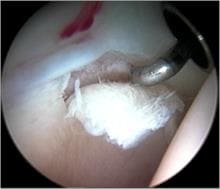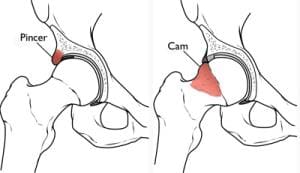Hip Impingement (Femoro-Acetabular Impingement)
Hip impingement or femoro-acetabular impingement (FAI) is a condition of where the ball shaped femoral head rubs abnormally or does not have a full range of movement, creating pain and damage.
The damage can occur to the articular cartilage (smooth surface of the ball or socket) or the labral cartilage (soft tissue bumper of the socket). FAI is a leading cause for the development of osteoarthritis, particularly in men.
The excess bone around the hip leads to friction and labral damage. Once the labrum has been injured, the hip joint surface (articular cartilage) becomes exposed and damaged due to on-going friction. This can lead to arthritis.

IMAGE AT ARTHROSCOPY SHOWING DAMAGED CARTILAGE WITH EXPOSED BONE
What causes Hip Impingement?
An abnormality in the shape of the hip joint bones may be present at birth or may develop in early childhood after some childhood hip conditions. In most cases the condition has been asymptomatic for many years. The abnormality may be a CAM deformity (this is excess bone on the ball part of the hip joint) or less commonly a Pincer deformity (excess bone around the rim of the hip socket).

Image showing CAM and Pincer Impingement
Why does it become painful?
When there has been enough damage in the joint, the first symptom is usually mild groin discomfort. Once the joint becomes painful, there is usually a gradual deterioration. Reducing activity levels may reduce the symptoms. The pain is caused by the torn labrum and damaged hip joint surface which occurs at the junction of the labrum and hip socket cartilage (chondro-labral junction).
What is the natural course of Hip Impingement?
Hip impingement or FAI causes hip discomfort and pain. Symptoms fluctuate according to activity levels and are often made worse by sport and activities which require deep bending of the hip (for example getting out of a car). Some patients report recurrent ‘groin sprains’ which typically are slow to settle or recur easily.
Over time, FAI causes progressive damage to the cartilage on the rim of the hip socket, leading to osteoarthritis. While osteoarthritis develops over a long time, surgical treatment of the abnormality causing FAI may slow or prevent the progression of joint damage and improve symptoms.
What treatment is available?
Non-surgical treatments are considered first; reducing or modifying activity levels, in combination with pain-killers and anti-inflammatory medication may provide relief. Surgical treatment depends on the type of hip impingement or FAI and its cause. In the absence of significant arthritis, many patients will benefit from hip arthroscopy (minimally invasive key-hole surgery).
What is hip arthroscopy?
Hip arthroscopy is key-hole surgery using a pencil sized fibre-optic camera. It allows the surgeon to safely and accurately assess damage to the joint and to perform corrective procedures. Hip arthroscopy is a minimally invasive procedure, useful in the treatment of FAI. Arthroscopy lends itself to a relatively rapid post-operative recovery.
At arthroscopy the cause for the impingement is removed (removal of CAM or pincer lesion) and the labrum is repaired. The damaged articular cartilage is also repaired (see ABICUS procedure).